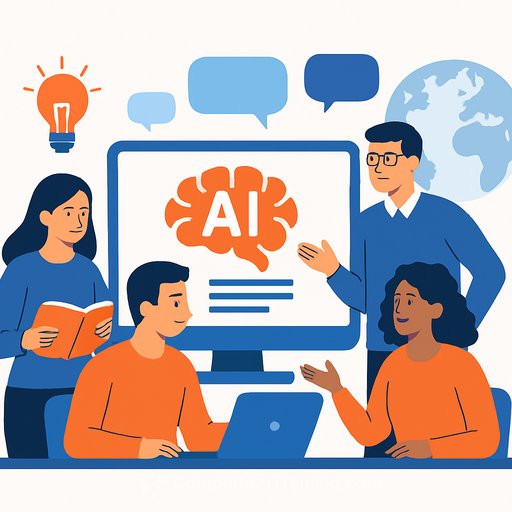AI in Education: Shift From Recall to Reasoning
A new paper from the University of Cambridge argues that AI can help students tackle the biggest problems on our plate - from the climate crisis to the health of democratic life - but only if we reframe how we teach and assess.
The authors warn that if schools cling to print-era assumptions and recall-based exams, generative AI becomes a "cognitive poison." Students under pressure to produce polished essays will offload to bots, and their own creative and critical growth stalls.
The alternative: make learning collaborative, conversational, and inquiry-led. Put students inside real dialogue with teachers, peers, and AI - and assess the quality of their thinking, not just the final product.
What Dialogic Learning Looks Like
Swap the lecture for a live question. Instead of dumping formulas, start with: "Why do objects fall to the ground?"
Students brainstorm in groups, then test ideas with an AI chatbot that can respond in the voice of Aristotle, Newton, or Einstein. They compare perspectives, challenge assumptions, and refine explanations together. The teacher guides the process and pushes for better reasoning.
Why This Shift Matters
- AI can already pass many traditional exams. That raises the bar for what school should measure.
- Future-ready learners need inquiry, collaboration, and judgment - the skills you develop in dialogue, not cramming.
- Global problems are complex. We need classrooms that model collective sense-making, not solo recall.
Practical Moves for Schools and Universities
- Redesign assessment to reward process: questioning, evidence use, comparison of sources, and how groups reason their way to conclusions.
- Make AI use visible: require prompts, drafts, citations, and a short reflection on how AI influenced the work.
- Use AI as "many minds": prompt it to adopt different theories, disciplines, and historical voices, then have students evaluate the differences.
- Shift more grading to oral defenses, group problem-solving, whiteboard talks, and portfolios with iterative feedback.
- Train teachers to facilitate discourse, craft prompts, and assess reasoning quality with clear rubrics.
- Set norms for ethical use: no AI-only submissions, source-checking habits, and bias checks on model outputs.
- Build equity into access: shared devices, offline options, and support for students with additional needs.
Avoiding the "Cognitive Poison" Trap
Overreliance on GenAI for polished prose can shrink agency and thinking. Counter it with structures that make thinking unavoidable and visible.
- Assess live reasoning: short viva-style checks or mini-conferences after major submissions.
- Require concept maps, hypothesis logs, and revision notes before any final draft.
- Design tasks AI can't complete alone: local data collection, community interviews, mixed-media artifacts, and cross-class debates.
- Grade the delta: improvement over time, not just the end product.
Quick Start: A 45-Minute Dialogic Lesson Template
- Question first (5 min): Pose a big, clear question tied to curriculum goals.
- Small-group talk (8 min): Students generate hypotheses and unknowns.
- Probe with AI (10 min): Query an AI in multiple "voices" or theories; capture contrasts.
- Whole-class synthesis (12 min): Compare claims, check evidence, resolve disagreements.
- Micro-assessment (5 min): One-minute write-up on "What changed my mind and why."
- AI reflection (5 min): Note how AI helped, where it misled, and what to verify next.
Policy Signals for Leaders
- Publish an assessment transition plan toward dialogic and portfolio-based evidence.
- Fund professional learning time for facilitation, prompt craft, and AI literacy.
- Adopt privacy, safety, and data standards for AI tools; audit vendor claims.
- Monitor effects on equity; provide access pathways and targeted support.
What the Researchers Emphasize
Rupert Wegerif notes that if a chatbot can clear our exams, we need to rethink what those exams mean. The point isn't to out-write a model; it's to build capacity for collaborative inquiry.
Imogen Casebourne points out the fork in the road: AI can strengthen dialogue and critical thinking - or weaken them - depending on how schools deploy and assess it.
Helpful Resources
- British Journal of Educational Technology - current research on AI and pedagogy.
- University of Cambridge Faculty of Education - research and projects on dialogic teaching.
Build Staff Capability
If you're setting up PD on AI for staff, start with practical, role-specific learning. Focus on assessment redesign, prompt strategies, and classroom routines that keep thinking front and center.
See AI course paths by job role to plan development across your team.
The takeaway: treat AI as a partner in dialogue, not a shortcut to answers. Design for thinking, grade the process, and make collaboration the core of learning. That's how we prepare students to work on problems that truly matter.
Your membership also unlocks:






